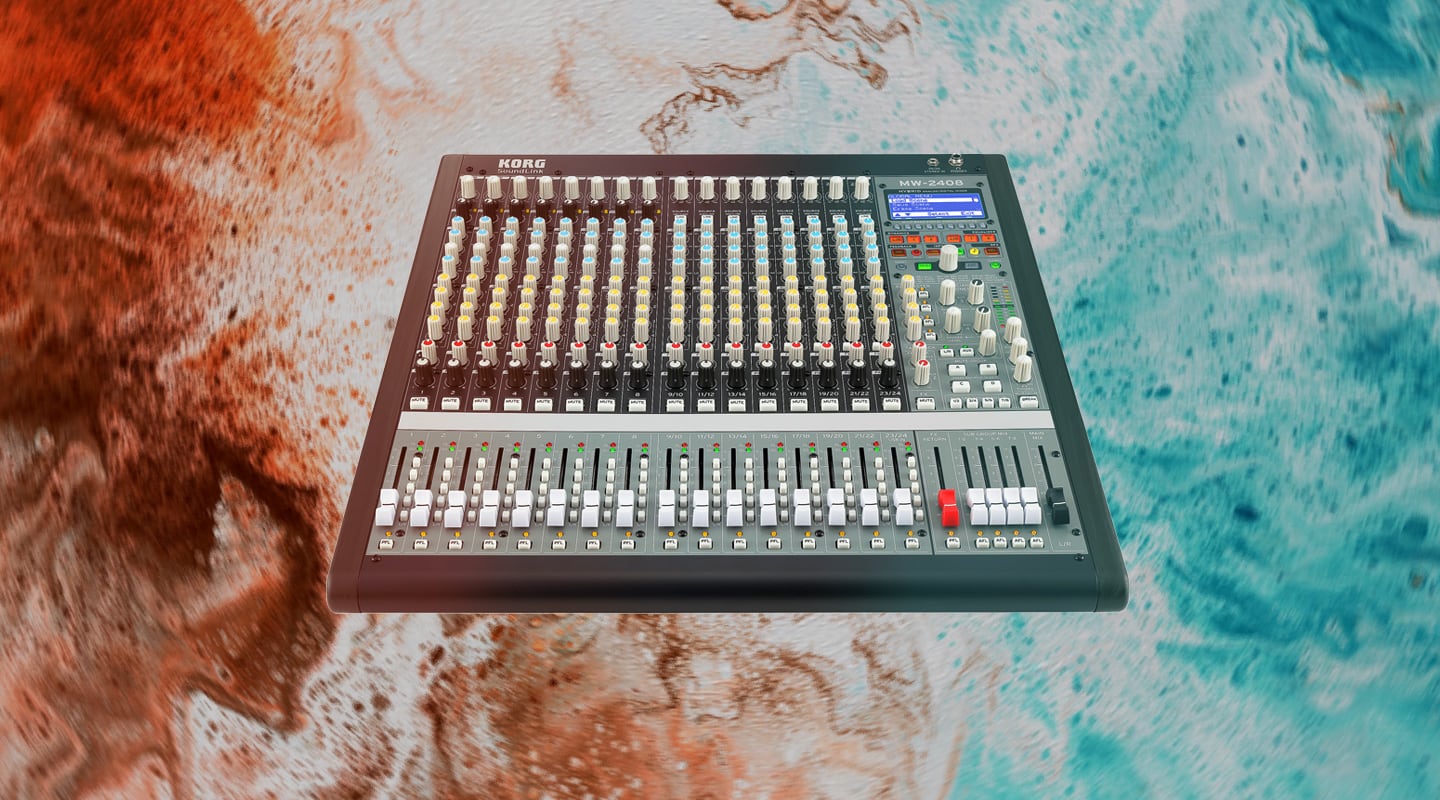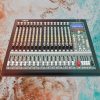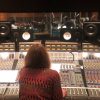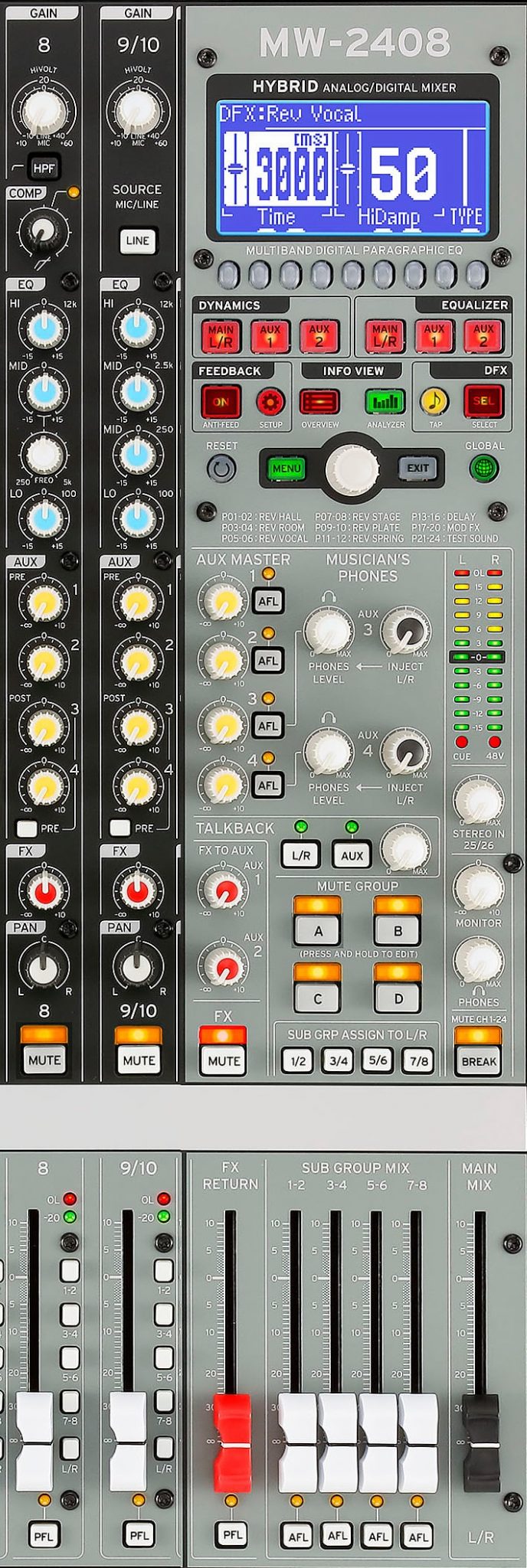
Review: Korg SoundLink MW2408 & 1608
The best console isn’t always a digital console. But this Greg Mackie-design ‘hybrid’ console may well be the droid you’re looking for.
A Korg mixer? It’s not entirely unheard of. Korg dipped its toe in this market around 20 years ago with the original SoundLink. It was white. In a world of black, Korg bucked the trend. SoundLink had its fans.
I was dubious. Who would buy a Korg mixer? The compact mixer market is saturated and you can get some great value. A Yamaha TF1 digital mixer with loads of DSP, goes for around $2600.
At the other end of the market, a Behringer 24:4:2 mixer can be purchased for under $600!
So what is Korg — with precious little mixing console pedigree — going to offer that an Allen&Heath or a Soundcraft or a Yamaha isn’t already? Actually, it’s madness, it’s as weird as Mackie releasing a hardware synth.
MACKIE TIME
Speaking of Mackie. Korg has one of those too. One of the two designers of the Korg SoundLink MW is none other than Greg Mackie — the godfather of the compact mixer and the original Mackie 8-Bus. Once you know that, so much about the design becomes clear. The distinctive Mackie pots, the colour scheme… there are Greg Mackie fingerprints all over SoundLink.
What’s more, I suspect Greg Mackie has had this console design in his back pocket for some time. I’m not exactly sure when the last Greg Mackie console was put into production but SoundLink could well be 10 years of beer mat sketches stacked into one design.
VALUE PROPOSITION?
As you can tell, my initial scepticism quickly turned into something else. This is a whole lot of mixer for under A$2400 (you can find the 16-channel version for around A$1900).
First up, it’s an analogue mixer. Yes, it has a digital section (effects, graphics, feedback elimination and more) but this is not a digital console in the way you might consider a PreSonus StudioLive or a Allen&Heath Qu mixer to be a digital mixer. The EQ and channel compression is analogue, for example. And the faders don’t move by themselves.
I had the 24-channel version in for review. When I unboxed it, my first reaction was — why did they make it wider than 19-inches?!. Of course, you dum dum, it absolutely is regulation rack width. But the console crams so much into that width that it’s almost like an optical illusion — it must be wider to fit 22 faders!
ROLL DOWN THE STRIP
Let’s take a whistle-stop tour of the channel strips:
The 24-channel version of the console features eight stereo channels. This recognises the fact that there’s plenty in today’s productions that require a stereo input, and two stereo channels (as might be more customary on a console this size) just won’t cut it.
That said, you can use the eight stereo channels as eight mono channels (they each feature a mic amp as well as the two jack inputs).
The stereo channels have a slightly different feature set. Four-band fixed frequency EQ, no HPF switch, and no compressor, are the main differences.
There’s one-knob compression on each of the mono channels — awesome. There’s a mute button with associated red LED on every channel (and not an annoying ‘On’ button without any LED).
The 10mm ALPS faders have a good feel. Each has a attendant signal present and overload LED. Each has a latching PFL button with LED. And each has routing buttons to send signal to the eight groups and mix bus.
The red fader is for FX Return. This is a luxury on a compact mixer and so very welcome.
NEED TO KNOW
Korg SoundLink MW2408 & 1608
Hybrid Analogue/Digital Mixer

THINK GROUP
The eight groups with corresponding eight outputs on the back, are a great feature. You can record stems with these outputs or use them as additional monitoring or breakout room outs in an install situation.
Speaking of I/O, there’s more than you could reasonably expect from a console in this class. I’ve already told you about the inputs, but I omitted to mention the front panel minijack stereo input (always welcome and always better than taking up an actual channel with a phone input).
There are plenty of output options apart from the eight group outputs I mentioned. There are two pairs of main outputs on jack and XLR, to run multiple loudspeakers or a pair of subwoofers and mains.
There’s a pair of monitor outputs as well, which is generous. You could run a local pair of powered monitors.
On the downside, there aren’t any TRS channel inserts for lassoing external effects and processing into your mix.
HYBRID BREED
The digital section is mediated through an old-school looking LCD. It’s not some kinda hi-res, capacitive touch OLED read out that’s showing a pseudo 3D render of a pinging limiter or a reverb model. It’s very basic. Reminds me of the display on my 20-year-old Yamaha 01V, if I’m honest.
The display may be rudimentary but the idea is to ensure nothing lurks more than a few button presses away.
There’s a 32-bit effects engine with the usual array of reverbs and delays. I’ve been fan of Korg’s effects for a long time so I didn’t need to be talked into this section. That said, the ability to fine tune the patches is limited, and for some reason the reverb tails on many of the presets are generally set to unfeasibly long decay times.
There are dynamics (compressor or gate) on the mains and the two monitor mixes (Aux 1 and 2), ditto graphic EQ and an effective feedback destroyer.
MORE ME PLEASE
The Master section includes the aux masters with controls. Aux 3 and 4 have a corresponding headphone amp output which is great for the rehearsal room. What’s more Greg Mackie has designed a nifty ‘more me’ monitor mix arrangement. You can send a variable amount of the L/R mix to the headphone mix. It makes it super easy to set up a headphone mix.
A talkback section allows you to route level to the auxiliaries or L/R bus via flashing switches.
Something else to add into the ‘I did not expect that’ category are four mute groups. Man, this is handy and very unexpected on a console like this. There are also large mute buttons for the FX section and all the channels (basically, a panic button if the PA is about to take off, for example, or you spot the guitarist about to pull his lead out of the DI without prior notice).
THREE-PRONGED ATTACK
The sound is led by the Peter Watts-designed preamps. Peter is best known for his work on the Trident consoles back in the ’80s. Greg Mackie lured him to Mackie Inc. when they were producing the D8B digital console — they’ve worked on and off ever since.
The preamps are relatively high voltage. The specs tell me they’re 16.5 Volts, and that means 16.5V across each of the stereo inputs as well.
Korg has gone all out with these mic preamps. I’m accustomed to the sound of great preamps thanks to a Midas Pro1 I do most of my mixing on. The Korg preamps are super-clean (no noise), and super detailed — the attack of a plectrum or snap of a snare, for example, are rendered in supreme detail. It takes many hours of gigging to fully get to know what you can and can’t do with a preamp, but the SoundLink’s pres feel very forgiving, with a wide sweetspot. I wouldn’t describe the preamps as esoteric or quirky and neither would I expect to on a workhorse mixer like this.
Regardless of how you use the console you’re also listening to the converters. Korg hasn’t skimped in this department with a 32-bit Velvet Sound AD/DA. And just generally, there’s lots of gain. You won’t feel like you’re struggling to get level out of this console.

MIXING WITH EARS
If you’re accustomed to mixing on a digital console, SoundLink will provide joy and some frustration. It’s absolutely, fall-off-a-log easy to work on. Pulling a mix together won’t require three workshops, messing about in a I/O matrix page, 10 hours of YouTube and an iPad logged into a forum for help. By observing some basic gain structure tenets and EQ, it’s easy to wrangle a mix and it’s easy to make it sound good — lots of clarity, width and focus. What you soon realise, is you don’t have an abundance of processing at every turn. You absolutely need to make the most of the one-knob channel compression and EQ. And, guess what, you have no choice but to use your ears — you have no recourse to a display showing a Cylon ping of a compressed vocal when you go to tweak the threshold.
The truth is, SoundLink isn’t so much pitched at those who are accustomed to working on digital consoles. Or if they are, then the SoundLink will be found in places where they can’t believe their luck that they’re working on a well-featured analogue mixing console… people not so different to Mr. Greg Mackie himself:

WORLD ACCORDING TO MACKIE
In the well-produced user manual, Greg Mackie talks about how he’s walked back from needing a digital console for certain weekend live sound applications. If you don’t know what you’re going to get on stage, then an analogue console is probably going to serve you better than a compact digital console where you’re always having to resort to a ‘fat channel’ for the channel functions — functions clearly laid out before you on the SoundLink.
I agree with Greg. And when I’m mixing on the SoundLink I do honestly feel like I’m mixing on Greg Mackie’s dream compact mixing console. It’s leaving the stuff that digital does best to the digital section, and the stuff that analogue does best, is laid out in front of you.
Clearly, if your work requires desk automation, then the SoundLink is not for you (you can save digital section setups but that’s where automation ends).
If you need a bunch of stereo auxiliaries for IEM, then this mixer is not for you.
If you can’t do without that mix bus plug-in or dynamic EQ, then this console is not for you.
If you need ‘more me’ monitor stations or apps on stage, then this isn’t the console for you.
In short, if you need digital console functionality, this mixer is not for you.
But the SoundLink has shown me one important thing: someone with a 16- or 24-channel analogue mixing console isn’t someone who just needs to get on with ‘upgrading’ to a digital console. There is undeniably a legitimate place for an analogue console of this type in theatres, churches, schools, rehearsal rooms, and smaller venues. In those cases, this isn’t a compromise console, it’s the perfect console.
















RESPONSES